
Humphrey DeForest Bogart, colloquially nicknamed Bogie, was an American actor. His performances in classic Hollywood cinema films made him an American cultural icon. In 1999, the American Film Institute selected Bogart as the greatest male star of classic American cinema.

Casablanca is a 1942 American romantic drama film directed by Michael Curtiz and starring Humphrey Bogart, Ingrid Bergman, and Paul Henreid. Filmed and set during World War II, it focuses on an American expatriate (Bogart) who must choose between his love for a woman (Bergman) and helping her husband (Henreid), a Czechoslovak resistance leader, escape from the Vichy-controlled city of Casablanca to continue his fight against the Germans. The screenplay is based on Everybody Comes to Rick's, an unproduced stage play by Murray Burnett and Joan Alison. The supporting cast features Claude Rains, Conrad Veidt, Sydney Greenstreet, Peter Lorre, and Dooley Wilson.

Peter Lorre was a Hungarian and American actor, active first in Europe and later in the United States. He began his stage career in Vienna, in the Austro-Hungarian Empire, before moving to Germany where he worked first on the stage, then in film in Berlin in the late 1920s and early 1930s. Lorre caused an international sensation in the Weimar Republic–era film M (1931), directed by Fritz Lang, in which he portrayed a serial killer who preys on little girls. Known for his timidly devious characters, his appearance, and his accented voice, Lorre was frequently caricaturized during and after his lifetime and the cultural legacy of his persona remains in media today.
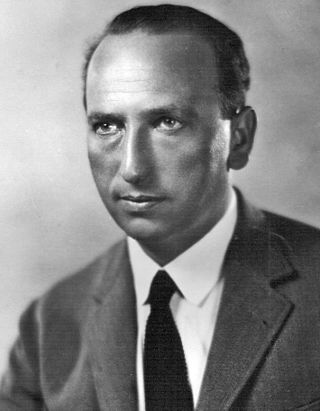
Michael Curtiz was a Hungarian-American film director, recognized as one of the most prolific directors in history. He directed classic films from the silent era and numerous others during Hollywood's Golden Age, when the studio system was prevalent.

Sydney Hughes Greenstreet was a British and American actor. While he did not begin his career in films until the age of 61, he had a run of significant motion pictures in a Hollywood career lasting through the 1940s. He is best remembered for the three Warner Bros. films - The Maltese Falcon (1941), Casablanca (1942), and Passage to Marseille (1944) - with both Humphrey Bogart and Peter Lorre. He portrayed Nero Wolfe on radio during 1950 and 1951. He became an American citizen in 1925.

The Mask of Dimitrios is a 1944 American film noir starring Sydney Greenstreet, Zachary Scott, Faye Emerson, Peter Lorre, and Victor Francen. Directed by Jean Negulesco, it was written by Frank Gruber, based on the 1939 novel of the same title written by Eric Ambler. Scott played the title role, of Dimitrios Makropoulos, in his film debut.

Beat the Devil is a 1953 adventure comedy film directed by John Huston, starring Humphrey Bogart, Jennifer Jones, and Gina Lollobrigida, in her American debut, and featuring Robert Morley, Peter Lorre and Bernard Lee. Huston and Truman Capote wrote the screenplay, loosely based upon the 1951 novel of the same name by British journalist Claud Cockburn writing under the pseudonym James Helvick. Huston made the film as a sort of loose parody of the 1941 film The Maltese Falcon, which Huston directed and in which Bogart and Lorre appeared. Capote said, "John [Huston] and I decided to kid the story, to treat it as a parody. Instead of another Maltese Falcon, we turned it into a... [spoof] on this type of film."
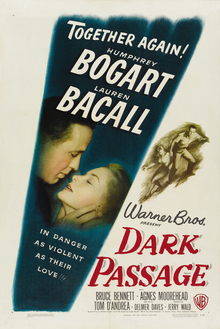
Dark Passage is a 1947 American mystery thriller film directed by Delmer Daves and starring Humphrey Bogart and Lauren Bacall. The film is based on the 1946 novel of the same title by David Goodis. It was the third of four films real-life couple Bacall and Bogart made together.
To Have and Have Not is a 1944 American romantic war adventure film directed by Howard Hawks, loosely based on Ernest Hemingway's 1937 novel of the same name. It stars Humphrey Bogart, Walter Brennan and Lauren Bacall; it also features Dolores Moran, Hoagy Carmichael, Sheldon Leonard, Dan Seymour, and Marcel Dalio. The plot, centered on the romance between a freelancing fisherman in Martinique and a beautiful American drifter, is complicated by the growing French resistance in Vichy France.

Helmut Dantine was an Austrian-American actor who often played Nazis in thriller films of the 1940s. His best-known performances are perhaps the German pilot in Mrs. Miniver and the desperate refugee in Casablanca, who tries gambling to obtain travel visa money for himself and his wife. As his acting career waned, he turned to producing.
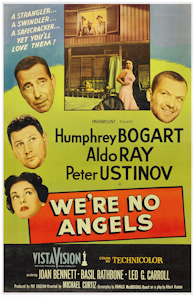
We're No Angels is a 1955 Christmas comedy film directed by Michael Curtiz, starring Humphrey Bogart, Peter Ustinov, Aldo Ray, Joan Bennett, Basil Rathbone, Leo G. Carroll, and Gloria Talbott. Shot in both VistaVision and Technicolor, the film was a Paramount Pictures release.

Conflict is a 1945 American black-and-white suspense film noir made by Warner Brothers. It was directed by Curtis Bernhardt, produced by William Jacobs from a screenplay by Arthur T. Horman and Dwight Taylor, based on the story The Pentacle by Alfred Neumann and Robert Siodmak. It starred Humphrey Bogart, Alexis Smith, and Sydney Greenstreet. The film is the only pairing of Bogart and Greenstreet of the five in which they acted together where Bogart rather than Greenstreet is the villain or corrupt character. There is also a cameo appearance of the Maltese Falcon statue.
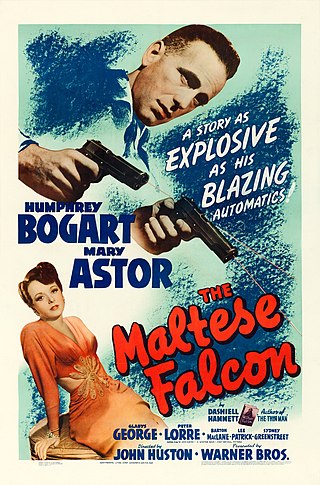
The Maltese Falcon is a 1941 American film noir in which a San Francisco private detective deals with three unscrupulous adventurers, all seeking a jewel-encrusted falcon statuette. Written and directed by John Huston in his directorial debut, the film was based on the 1930 novel The Maltese Falcon by Dashiell Hammett and is a remake of the 1931 film of the same name. It stars Humphrey Bogart as private investigator Sam Spade, Mary Astor as his femme fatale client, and as villains Peter Lorre and Sydney Greenstreet.
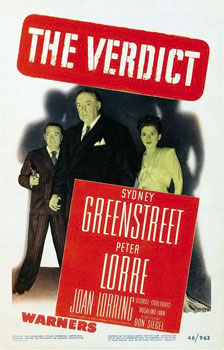
The Verdict is a 1946 American film noir mystery drama film directed by Don Siegel and written by Peter Milne, loosely based on Israel Zangwill's 1892 novel The Big Bow Mystery. It stars Sydney Greenstreet and Peter Lorre in one of their nine film pairings, as well as Joan Lorring and George Coulouris. The Verdict was Siegel's first full-length feature film.

Across the Pacific is a 1942 American spy film set on the eve of the entry of the United States into World War II. It was directed first by John Huston, then by Vincent Sherman after Huston joined the United States Army Signal Corps. It stars Humphrey Bogart, Mary Astor, and Sydney Greenstreet. Despite the title, the action never progresses across the Pacific, concluding in Panama. The original script portrayed an attempt to avert a Japanese plan to invade Pearl Harbor. When the real-life attack on Pearl Harbor occurred, production was shut down for three months, resuming on March 2, 1942, with a revised script changing the target to Panama.

Three Strangers is a 1946 American film noir crime drama directed by Jean Negulesco and starring Sydney Greenstreet, Geraldine Fitzgerald, and Peter Lorre, and featuring Joan Lorring and Alan Napier. The screenplay was written by John Huston and Howard Koch. It was produced and distributed by Warner Brothers.

Dive Bomber is a 1941 American aviation film from Warner Bros. Pictures, directed by Michael Curtiz, and starring Errol Flynn and Fred MacMurray. The film is notable for both its Technicolor photography of pre-World War II United States Navy aircraft and as a historical document of the U.S. in 1941. This includes the aircraft carrier USS Enterprise, one of the best-known U.S. warships of World War II.

Chain Lightning is a 1950 American aviation film based on the story "These Many Years" by blacklisted writer Lester Cole ; the screenplay was written by Liam O'Brien and Vincent B. Evans. During World War II, Evans had been the bombardier on the Boeing B-17 Flying Fortress Memphis Belle.
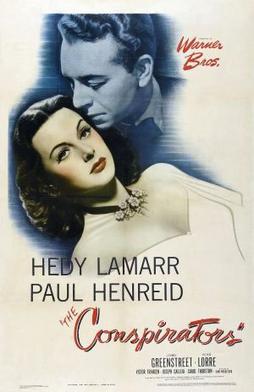
The Conspirators is a 1944 American film noir, World War II, drama, spy, and thriller film directed by Jean Negulesco. It stars Hedy Lamarr and Paul Henreid, features Sydney Greenstreet and Peter Lorre in supporting roles, and has a cameo of Aurora Miranda singing a Fado. The Conspirators reunites several performers who appeared in Casablanca (1942).
Casablanca is an hour-long American television series, in the genre of spying and intrigue during the Cold War, which was broadcast on ABC between September 27, 1955 and April 24, 1956 as part of the wheel series Warner Bros. Presents. The third of 20 filmed shows produced for ABC, between 1955 and 1963, by Warner Bros. Television, under the supervision of executive producer William T. Orr, Casablanca is also the only one among those shows to be structured in the form of a non-U.S.-based Cold-War-intrigue storyline, while 14 of the 20 productions were western and detective/adventure series.


















